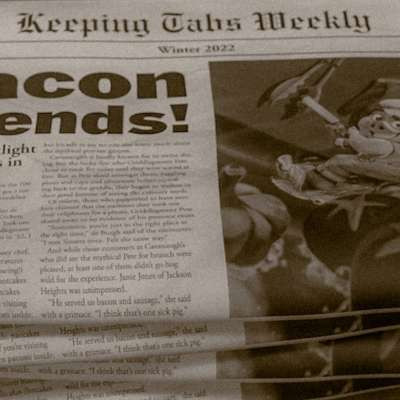"Squank Wrote My Book!"
Noted Psychiatrist Claims Imaginary Creature as Source for Bestselling Self-Help Book
Keeping Tabs Weekly, Spring 2024
Dr. Edgar J. Gallagher, author of Happily Miserable, the self-help chapbook released last Christmas that other psychiatrists panned as “banal,” “uninspiring,” and “truly miserable” despite record-setting sales, has launched a media blitz to attribute the book’s contents to a make-believe creature.
Speaking from the steps of City Hall in Johnstown, Pennsylvania, where tales of Squonk, a creature of folklore, originated over a hundred years ago, Gallagher said, “I can no longer take sole credit for the contents of the book Happily Miserable. The truth is, Squonk wrote it for me.”
In late 2022, Gallagher said he spent a few days lodging at Heritage House, a local bed and breakfast, in the aftermath of a divorce.
“I came in search of solitude,” he said, “and a drive-in movie theater for solace. But I found so much more.”
While exploring Johnstown one evening, Gallagher claimed he encountered a diminutive blue-skinned creature weeping inconsolably by the river’s edge. Its wrinkled flesh sagged on its face, Gallagher noted, and its sizable bulbous nose ran incessantly.
“I was quite empathetic regarding its feelings—I experienced similar heartbreak when I was a teenager—but despite human emotions, it clearly wasn’t human,” he explained. “Just the same, it cried like a dungeon master on prom night.”
The creature, which Gallagher colorfully described as “more disgusting than blobfish bits in a durian salad,” would bawl great streams of tears, which pooled around its flat feet until it could see itself reflected in the surface. When that happened, he said, the creature—whom he identified as Squonk based on his communications with it—would turn its face away and weep anew at its own homeliness.
“Its face was a dermatologist’s dream,” he said. “The Vesuvius of facial eruptions. Warts, moles, all manners of discharge and disgust. I cried right alongside it, I will confess. We could all be kinder if we pitied ugliness more.”
That concept, encapsulated in the witticism “pity the hiddy” (i.e., “hideous”), is just one of numerous gems of advice in Gallagher’s chapbook. Happily Miserable offers 96 pages of insights into unhappiness that the psychiatrist said were “born from my interactions with Squonk.”
Imaginative Advice?
“To be better looking, you’re better off not looking at yourself.”
“Crying dampens the spirit but frees the soul.”
“Spend your time with people notably uglier than you so that you can be the prettiest one.”
Dr. Gallagher added a short paragraph and a cartoonish image to each entry, images that are clearly representative of the imaginary creature Squonk.
“We spent a great deal of time together,” Gallagher insisted. “In that time, I was able to assess Squonk’s tendency to weep as a number of different routes to managing its sadness: Emotionally, socially, cognitively, and physiologically, Squonk needs to cry."
Though met with derision, the psychiatrist admitted he’d kept his source secret up until the beginning of his current media blitz because he considered it probable that Squonk would become even more dejected to hear itself discredited publicly.
“We are all Squonk,” he said, pointing to journalists in the gathered crowd. “You, and you, and you. We would all cry ourselves rivers if faced daily with the harsh realities of our appearance, our sense of self-worth, our societal value. I myself asked myself repeatedly in the wake of my divorce: am I so unappealing? Do I lack charisma entirely? Am I, in fact, ugly?”
When one reporter jokingly asked why Gallagher had been cashing royalty checks if the mythical Squonk had actually crafted Happily Miserable, the psychiatrist answered with sincerity.
“I might be ugly,” he said, “but I’m not stupid.”




